Fantasia 2018, Day 9: A Rough Draft and The Man Who Killed Hitler and Then The Bigfoot
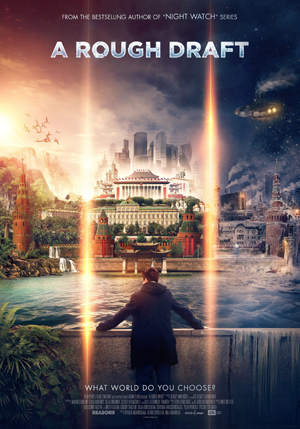 I’ve said that the last two movies I saw on Thursday, July 19, did different things with weirdness: one extremely weird in its way, the other unweird to a surprising degree. As it turned out, the same could be said of the two movies I saw on Friday, July 20. The first (at the J.A. De Sève) was a Russian film, A Rough Draft. The second (at the larger Hall Theatre) was American, The Man Who Killed Hitler and Then The Bigfoot. From those titles you might not guess which movie had the weirdness and which didn’t. But that’s the reward of watching things at Fantasia: the chance of the wholly unexpected.
I’ve said that the last two movies I saw on Thursday, July 19, did different things with weirdness: one extremely weird in its way, the other unweird to a surprising degree. As it turned out, the same could be said of the two movies I saw on Friday, July 20. The first (at the J.A. De Sève) was a Russian film, A Rough Draft. The second (at the larger Hall Theatre) was American, The Man Who Killed Hitler and Then The Bigfoot. From those titles you might not guess which movie had the weirdness and which didn’t. But that’s the reward of watching things at Fantasia: the chance of the wholly unexpected.
A Rough Draft (Chernovik, Черновик) was directed by Sergey Mokritskiy from a script he wrote with Maksim Budarin, Denis Kuryshev, and Olga Sobenina, adapting a novel by Sergey Lukyanenko. Kirill (Nikita Volkov) is a successful computer game designer in Moscow — until he begins to disappear from the memory of his friends and family. Reality has changed, and he’s no longer part of it. He confronts the woman who seems to be the cause, Renata (Severija Janusauskaite). Kirill, we learn, has become a Functional, a person with superhuman powers; he’s been drafted to serve as a customs officer in a stone tower that’s a gateway between worlds. Mysteries abound. Can he get back to his family and to the love of his life, Anna (Olga Borovskaya)? And will he find the mysterious other reality, Arkan, that is 30 years ahead of our own and thus a rough draft for our own world?
A Rough Draft plays like a film that’s supposed to be a blockbuster. It’s full of big ideas, bright visuals, and the unexpected. Whole universes can lurk behind a door. At every turn it seems like a new concept or gimmick’s being introduced. Which is really why it goes off the rails so spectacularly, in ways an American blockbuster would never be allowed to do. It’s a train wreck, but a fascinating, entirely watchable train wreck. After the movie ended, seven of us gathered in the atrium outside the De Sève Theatre to form an impromptu therapy group trying to work through what it was that we’d just seen. While this felt necessary, it was pointless. It’s not possible to make what’s on screen make sense as a coherent whole. Too many pieces are missing. But I’d very much like to read Lukyanenko’s original novel.
The first act of the film, in which Kirill finds himself being erased from everyone’s memories, is simple enough. We’ve seen this before — a man being wiped out of the world, a man being initiated into a new life with strange and secret powers. It moves well; Volkov brings Kirill’s astonishment across; the mystery’s enough to make us want to see what happens next. And then the chaos begins. We start getting ideas thrown at us hard and fast, and halfway through an explanation of one idea another breaks in on us and we get some of the basics on that and never end up getting the rest of the explanation of the first. Meanwhile another three things have happened.
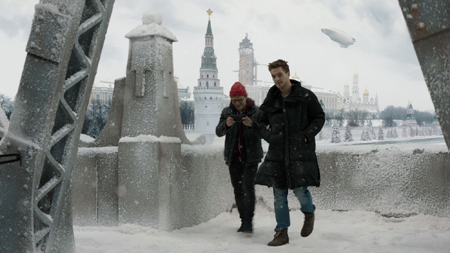 Kirill’s bound to the tower where different words can be accessed. People are travelling between worlds, though we never get a strong sense of who. Some of them are trading goods, though again it’s unclear with whom. Kirill can open the doors in the tower, and then sometimes when he can create new ones. The tower’s a few stories tall, except as new doors are added (I think), although we never see that. Kiril can make a lot of new doors, which makes him a natural at his job, which he somehow knows how to do though we don’t understand why. Also the tower can make things for him and control reality within it. Oh, and Kirill has a mysterious boss, who he never meets and wants to find. This is all for starters, and if it seems a bit all over the place I haven’t gotten to the actual alternate realities yet.
Kirill’s bound to the tower where different words can be accessed. People are travelling between worlds, though we never get a strong sense of who. Some of them are trading goods, though again it’s unclear with whom. Kirill can open the doors in the tower, and then sometimes when he can create new ones. The tower’s a few stories tall, except as new doors are added (I think), although we never see that. Kiril can make a lot of new doors, which makes him a natural at his job, which he somehow knows how to do though we don’t understand why. Also the tower can make things for him and control reality within it. Oh, and Kirill has a mysterious boss, who he never meets and wants to find. This is all for starters, and if it seems a bit all over the place I haven’t gotten to the actual alternate realities yet.
The visual realisation of those other worlds Kirill visits are engaging. They’re unreal, the CGI just a bit cartoony, but still somehow credible — these are places that literally aren’t real, so expecting the grit and grime of reality feels wrong. Again here Volkov sells his belief in these places, a tropical island or a steampunk fantasy Moscow or a Soviet-like prison city. In an understated way I thought Volkov was really the anchor for the movie. Nothing else here makes sense, but he’s always clear about what Kirill thinks and fears and wants. That’s enough to keep something like a story moving forward, even if Kirill himself is a rather generic character. At least what is generic can be understood
 It’s difficult to explain how otherwise incomprehensible this film is. One of the other critics observed that you kept finding yourself three minutes into a scene with no idea what was happening or why or how the characters got there. The mechanics of the reality don’t make sense; the rules are arbitrary and underexplained, so when we find out that Kirill’s a kind of prodigy among customs officers it comes out of nowhere and still seems to mean nothing. Character motivations don’t make sense; why does Kirill not try to take control of his tower, for example? It can make all kinds of things for him, whatever he wants, and he is literally a game designer — why not try to game the rules? Backstory is unclear or inconsistent or irrelevant — Kirill’s best friend, who forgets him in the first act, remembers him when Kirill finds him again.
It’s difficult to explain how otherwise incomprehensible this film is. One of the other critics observed that you kept finding yourself three minutes into a scene with no idea what was happening or why or how the characters got there. The mechanics of the reality don’t make sense; the rules are arbitrary and underexplained, so when we find out that Kirill’s a kind of prodigy among customs officers it comes out of nowhere and still seems to mean nothing. Character motivations don’t make sense; why does Kirill not try to take control of his tower, for example? It can make all kinds of things for him, whatever he wants, and he is literally a game designer — why not try to game the rules? Backstory is unclear or inconsistent or irrelevant — Kirill’s best friend, who forgets him in the first act, remembers him when Kirill finds him again.
The pacing’s quick enough that you almost don’t think about what’s wrong. You follow Kirill as in a dream. He has powers, he has limitations, he has a woman he wants to save from bad guys, he has a universe with mysteries to solve. As I say, it’s generic enough that at some level it’s understandable. But the plot makes no sense. It’s as if half the dialogue, the bits that explained the linkages among ideas and scenes, have simply been excised. I don’t think this is am issue with the translation (though I might be wrong); it’s so consistent, affecting so many parts of the film, I think it’s simply a function of how the movie was put together.
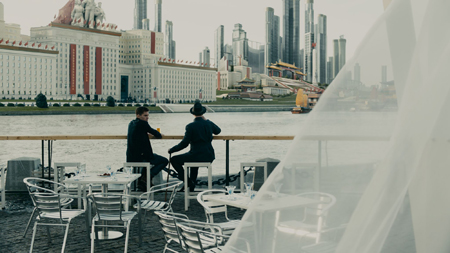 There are some admirably big ideas in the film, beyond the excellent design work — vicious giant matryoshka security robots being a particular stand-out. Thematically, the movie wants to deal with history; Kirill’s father’s a historian, and a mid-film attempt by Kirill to return to his parents is about as close as the film gets to emotional affect. But a Soviet-style reality, as well as what we learn about Arkan in the climactic scenes, do feel like an attempt in some way to wrestle with modern Russian history. The problem, of course, is that it’s difficult to be sure how to read it given the overall incoherency. Is Kirill’s erasure in the opening scenes analogous to Trotsky getting wiped out of a Stalin-era photograph? I have no idea; I wouldn’t think so if not for some of the other moments in the film, but I’m really not sure whether the parallel’s intended or not.
There are some admirably big ideas in the film, beyond the excellent design work — vicious giant matryoshka security robots being a particular stand-out. Thematically, the movie wants to deal with history; Kirill’s father’s a historian, and a mid-film attempt by Kirill to return to his parents is about as close as the film gets to emotional affect. But a Soviet-style reality, as well as what we learn about Arkan in the climactic scenes, do feel like an attempt in some way to wrestle with modern Russian history. The problem, of course, is that it’s difficult to be sure how to read it given the overall incoherency. Is Kirill’s erasure in the opening scenes analogous to Trotsky getting wiped out of a Stalin-era photograph? I have no idea; I wouldn’t think so if not for some of the other moments in the film, but I’m really not sure whether the parallel’s intended or not.
Either way, this movie ends on a cliffhanger that’s not really a cliffhanger, promising a fight that hasn’t been really hinted at in the film to date. It’s a suitably baffling conclusion. I don’t think the promised sequel will materialise — this movie apparently didn’t do well at the box office at home or abroad. But much as there are any number of better things to spend money on, I’d be lying if I said I wasn’t disappointed. This is in no way a good movie. But it’s entertaining, somehow, in some way I can’t describe, even as it’s nonsensical. There’s a world here that makes sense in the director’s head, or maybe Lukyanenko’s head, and if we only really get flashes of that, there’s something engaging here anyway. I don’t recommend watching this, except … once it gets going, if you have no expectations at all, you might find it memorably weird in a way big-budget special-effects movies aren’t supposed to be. A Rough Draft lives up to its title: flawed, at points incoherent, but not lacking in promise and interest.
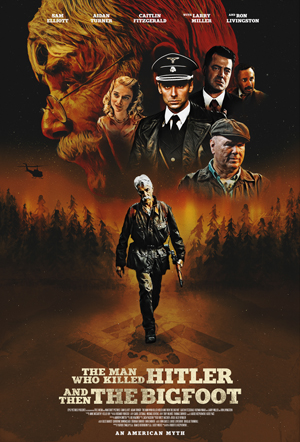 Then came The Man Who Killed Hitler and Then The Bigfoot. The feature debut of writer/director Robert D. Krzykowski, it stars Sam Elliott (who’s been in everything from Road House to Tombstone to The Big Lebowski to the Ang Lee Hulk) as Calvin Barr, an old man in a time not so long ago, who, when pushed, is capable of surprisingly efficient acts of violence. He’s the man that agents of the American and Canadian governments seek out when Bigfoot must be killed — for Bigfoot has become a plague carrier. Why Barr? Because, decades before (in flashback scenes where he’s played by Aidan Turner, the lead in TV’s Poldark), he was the man who really killed Adolph Hitler.
Then came The Man Who Killed Hitler and Then The Bigfoot. The feature debut of writer/director Robert D. Krzykowski, it stars Sam Elliott (who’s been in everything from Road House to Tombstone to The Big Lebowski to the Ang Lee Hulk) as Calvin Barr, an old man in a time not so long ago, who, when pushed, is capable of surprisingly efficient acts of violence. He’s the man that agents of the American and Canadian governments seek out when Bigfoot must be killed — for Bigfoot has become a plague carrier. Why Barr? Because, decades before (in flashback scenes where he’s played by Aidan Turner, the lead in TV’s Poldark), he was the man who really killed Adolph Hitler.
This sounds like a wild pulpy adventure, but in fact it’s absolutely nothing of the sort. It’s a calm, measured film about growing old and the long-term cost of violence. Meditative and quiet, the movie focusses on Elliott and his weathered face, as he ponders not some scheme of violence or revenge, but simple everyday questions of how to go about living in his old age alone except for his younger brother Ed (Larry Miller). The high-concept genre framework is almost ignored for the sake of presenting a low-key character study.
The movie lives or dies on the acting, then, and Elliott and Turner both succeed at their parts. Elliott in particular feels like he’s become Calvin Barr, haunted by a past we gradually come to understand as the movie goes on. Guilt and PTSD and the cost of violence don’t go away even if the man you’ve killed is literally Hitler. Elliott’s line deliveries are as solid as a granite mountain; he makes us believe, makes us feel Barr’s no super-hero but a real man with a real past. Turner gives us a contrast, a younger and eager man, more puppylike, ready to fall in love, ready to do what his country asks.
The movie’s spectacularly well-shot, richly coloured, with dark shadows always lurking about. Emotionally this matches the action and feel of the film. Conversely, the scenes in the wild, as Barr hunts the Bigfoot, are bright and beautiful. Sunlight and sunsets set a palette that defines a kind of primal mood. If elsewhere the film’s moodier, there it’s rich and mythic.
That said, the hunt is surprisingly brief. In this as in many other things the movie chooses to defy easy expectations and genre labels. In the end I’m not sure it works. There’s a specific feel that comes from this approach, certainly. This isn’t much like other movies. At the same time, the framework of genre exists for a reason. In a good genre story, character can’t be divided from the genre elements: those elements become the way by which character and theme are explored. The intentionally rudimentary use of genre elements here means that insofar as this is a genre story, character can only be explored in a rudimentary way.
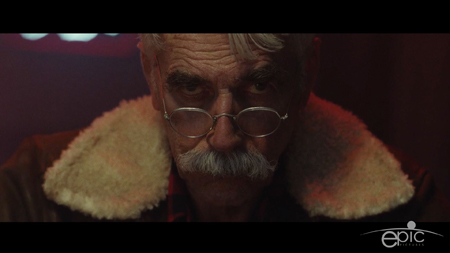 Is there any other, non-genre, way the film works to bring out character? Not in terms of obvious drama. Barr’s decisions are decisions made about the genre aspects — whether or not to hunt Bigfoot, how he goes about it, and the like. Other choices he makes are informed by what he finds on his hunt, or by memories of his experiences in World War Two. This is a genre story, but one that shuns the energy and structure genre usually provides. As a result, there’s a curiously random feel to the movie, notwithstanding the fact that not very much happens.
Is there any other, non-genre, way the film works to bring out character? Not in terms of obvious drama. Barr’s decisions are decisions made about the genre aspects — whether or not to hunt Bigfoot, how he goes about it, and the like. Other choices he makes are informed by what he finds on his hunt, or by memories of his experiences in World War Two. This is a genre story, but one that shuns the energy and structure genre usually provides. As a result, there’s a curiously random feel to the movie, notwithstanding the fact that not very much happens.
It may be that I’m misreading the film, in the sense that it seems now and again to be reaching beyond genre for something like myth. Elliott provides the feel of a legendary hero in his old age, the gravitas and experience of a great figure in the autumn of his years. There are echoes, here and there, of myth-tales: Bigfoot maybe like a Prometheus on the rock, Elliott recognised at one point by his dog like the returning Odysseus. But I didn’t find these things more than brief nods. There’s too much realism in this film for it to feel like either myth or adventure. And since the drama’s relatively underdeveloped, I don’t see that it’s especially effective as a character piece; there simply isn’t enough for Barr to do for the movie to succeed as a realist narrative.
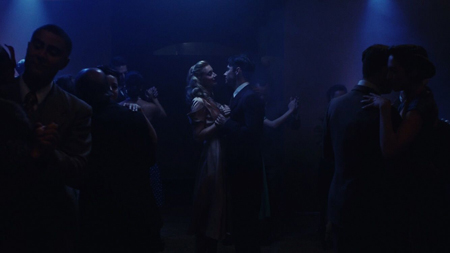 The extensive use of flashbacks doesn’t help much, either. Individually they’re fine, with a strong sense of period. Collectively, though, they slow the story down even further. They’re not crucial to the plot, by and large; they’re about Barr, about how he became who he is. So they emphasise the character-centred aspect of the film, which is fine, but also they’re about a secret mission to assassinate Hitler, which is difficult to parse as character work. There’s a love story shown in some of the flashbacks, too, but the strong implication that this relationship should be taken as a key to Barr’s character feels untenable. (As well, the last flashback comes too near the end of the film, further enervating the dramatic structure.)
The extensive use of flashbacks doesn’t help much, either. Individually they’re fine, with a strong sense of period. Collectively, though, they slow the story down even further. They’re not crucial to the plot, by and large; they’re about Barr, about how he became who he is. So they emphasise the character-centred aspect of the film, which is fine, but also they’re about a secret mission to assassinate Hitler, which is difficult to parse as character work. There’s a love story shown in some of the flashbacks, too, but the strong implication that this relationship should be taken as a key to Barr’s character feels untenable. (As well, the last flashback comes too near the end of the film, further enervating the dramatic structure.)
I believe that Krzykowski has a definite vision in his head for this film. But I can’t understand it. The balance of genre elements and realistic character drama don’t make obvious sense to me. It’s a well-crafted film, and the cinematography I feel brings out moods and tones very well. But the drama’s rudimentary. The logic of the movie’s weird, ignoring the high-concept strangeness of its premise for the sake of realistic depiction of character — but the conception of character is not itself especially deep. Indeed, Calvin’s a genre stand-by — the old warrior facing one last battle despite having turned against war. The Man Who Killed Hitler and Then The Bigfoot has some good ideas, but seems uninterested in exploring them.
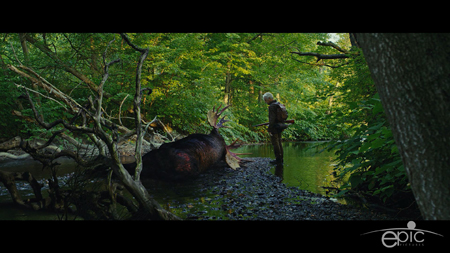 After the movie, Krzykowski came out with star Sam Elliott. The first question to Krzykowski was about the 12-year-long journey it took to make the film. He said he started writing it in 2005 as a pulp adventure story; that changed over time, as he lost friends, and he wanted to find a story with two big bookends and a heart in the middle, a story about how we treat each other. Elliott was asked to comment on this, and he said he was touched by the script, that it spoke to him. He observed that it’s always a strange thing to get a new script; if it’s good you’re about to start on a long journey with the story. He remembered that there were two cover letters to the script, one simpler and one very deep (as, he said, Krzykowski always is on some level). Elliott said he remembered being perplexed by the title, but knew he wanted to be involved; what’s on the page is what matters, he said, and after speaking on the phone with Krzykowski he knew he wanted to work with him.
After the movie, Krzykowski came out with star Sam Elliott. The first question to Krzykowski was about the 12-year-long journey it took to make the film. He said he started writing it in 2005 as a pulp adventure story; that changed over time, as he lost friends, and he wanted to find a story with two big bookends and a heart in the middle, a story about how we treat each other. Elliott was asked to comment on this, and he said he was touched by the script, that it spoke to him. He observed that it’s always a strange thing to get a new script; if it’s good you’re about to start on a long journey with the story. He remembered that there were two cover letters to the script, one simpler and one very deep (as, he said, Krzykowski always is on some level). Elliott said he remembered being perplexed by the title, but knew he wanted to be involved; what’s on the page is what matters, he said, and after speaking on the phone with Krzykowski he knew he wanted to work with him.
Asked if there were any specific things he did to prepare, Elliott said no, he felt old enough and beat-up enough at this point in his life. He said he believed in the words he was given, and believed in Calvin. He spoke about getting to know the people working on the film, observing that people are the ones who make a project special. Asked if he was particularly interested in working with first-time filmmakers, Elliott said he liked working with young filmmakers, especially when they have something to say. It’s a fast-changing world, he reflected, in film and out, and there are things in movies he likes and doesn’t like — but he particularly likes indie films unencumbered by studios. Studios almost dare you to to make a movie; it’s better, he said, to simply go away and tell a story.
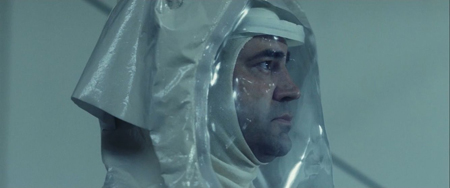 Krzykowski was asked about Douglas Trumbull, who contributed visual effects to the movie; Trumbull worked on 2001, Close Encounters, Star Trek: The Motion Picture, and Blade Runner, among others. Krzykowski described meeting him when he and other filmmakers were invited to a demonstration of Trumbull’s MAGI cinema system; Krzykowski approached him as the Man Who Killed Hitler was being prepared, and Trumbull had seen a short film he’d done. Krzykowski spoke about the range of techniques Trumbull brought, and how they’re present all through the movie without being obvious. Trumbull brought in Rocco Gioffre, one of the best matte painters in the world: “I don’t really understand how some of this happened.”
Krzykowski was asked about Douglas Trumbull, who contributed visual effects to the movie; Trumbull worked on 2001, Close Encounters, Star Trek: The Motion Picture, and Blade Runner, among others. Krzykowski described meeting him when he and other filmmakers were invited to a demonstration of Trumbull’s MAGI cinema system; Krzykowski approached him as the Man Who Killed Hitler was being prepared, and Trumbull had seen a short film he’d done. Krzykowski spoke about the range of techniques Trumbull brought, and how they’re present all through the movie without being obvious. Trumbull brought in Rocco Gioffre, one of the best matte painters in the world: “I don’t really understand how some of this happened.”
Elliott was then asked what his favourite role in his filmography was, and he said that although it was the most common question he got it always left him perplexed. Most films had things that made them special. He mentioned a Louis L’Amour film, Conagher; he also thought there were special things about this film, though he said he may just be getting more sentimental. He said Mask, Road House, and Tombstone all had things about them. Asked if Man Who Killed Hitler was demanding to shoot, Elliott said he was actually fine with it, as though he was just in the right zone. He walked a lot to keep in good health; he used to run before blowing out an MCL: “I’ve got some cadaver in my knee. It’s kind of a trip.” Overall, “there were moments [of strain] probably. But I didn’t go home at night thinking ‘What have I gotten myself into?’”
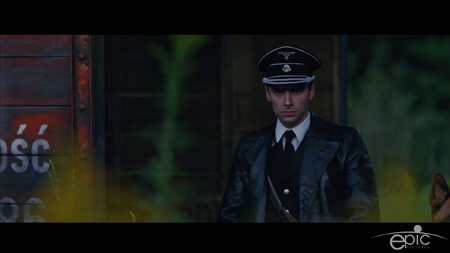 Asked about the use of parallel stories in past and present, Krzykowski said he wanted to balance two love stories, with Calvin and a girl in the past, and Calvin and his brother in the present. He talked about some of the decisions involved in the hunt for the Bigfoot, concluding that the most cinematic thing to do was the most enjoyable. Asked how he cast a young Elliott, Krzykowski said he told his casting director he wanted somebody with an unpretentious cool. Aidan Turner wanted to do a respectful performance, and not try to imitate Elliott’s voice; his performance was subtle, paying attention to the way Elliott’s Barr communicated ideas. Krzykowski then chose particularly Elliott-like glimmers in editing. He also talked to Sam to make sure he accepted the man who was playing his younger self.
Asked about the use of parallel stories in past and present, Krzykowski said he wanted to balance two love stories, with Calvin and a girl in the past, and Calvin and his brother in the present. He talked about some of the decisions involved in the hunt for the Bigfoot, concluding that the most cinematic thing to do was the most enjoyable. Asked how he cast a young Elliott, Krzykowski said he told his casting director he wanted somebody with an unpretentious cool. Aidan Turner wanted to do a respectful performance, and not try to imitate Elliott’s voice; his performance was subtle, paying attention to the way Elliott’s Barr communicated ideas. Krzykowski then chose particularly Elliott-like glimmers in editing. He also talked to Sam to make sure he accepted the man who was playing his younger self.
Asked if there was any kind of movie he wanted to do in future, Krzykowski said he wanted to tell any story that talks about how we treat one another, and who we are as human beings. He likes every kind of movie. Finally, he was asked what it was like for him working with such an established actor. He recalled talking on the phone with him, having extended discussions; and he talked about the intensity Elliott brought to his part, how the emotional depth he brought every day changed the movie. He said Elliott was a good man who taught him a lot about himself; also, the crew loved him. He said that the most special thing about getting to make a movie is getting to work with somebody he admires who trusted him for some reason — “I don’t know why,” he concluded.
“I don’t know either,” reflected Elliott, and that ended the night.
Find the rest of my Fantasia coverage here!
Matthew David Surridge is the author of “The Word of Azrael,” from Black Gate 14. You can buy his first collection of essays, looking at some fantasy novels of the twenty-first century, here. His second collection, looking at some fantasy from the twentieth century, is here. You can find him on Facebook, or follow his Twitter account, Fell_Gard.